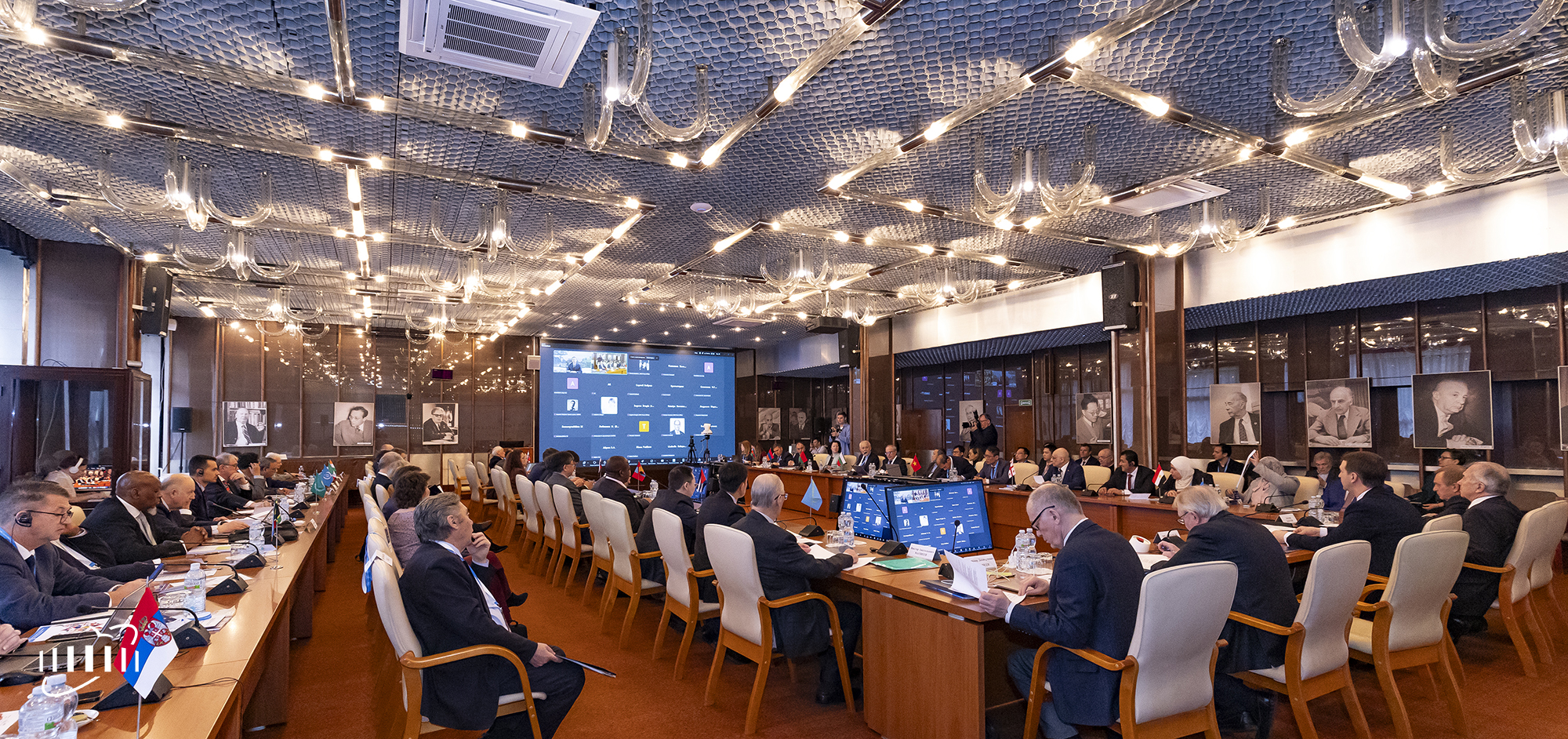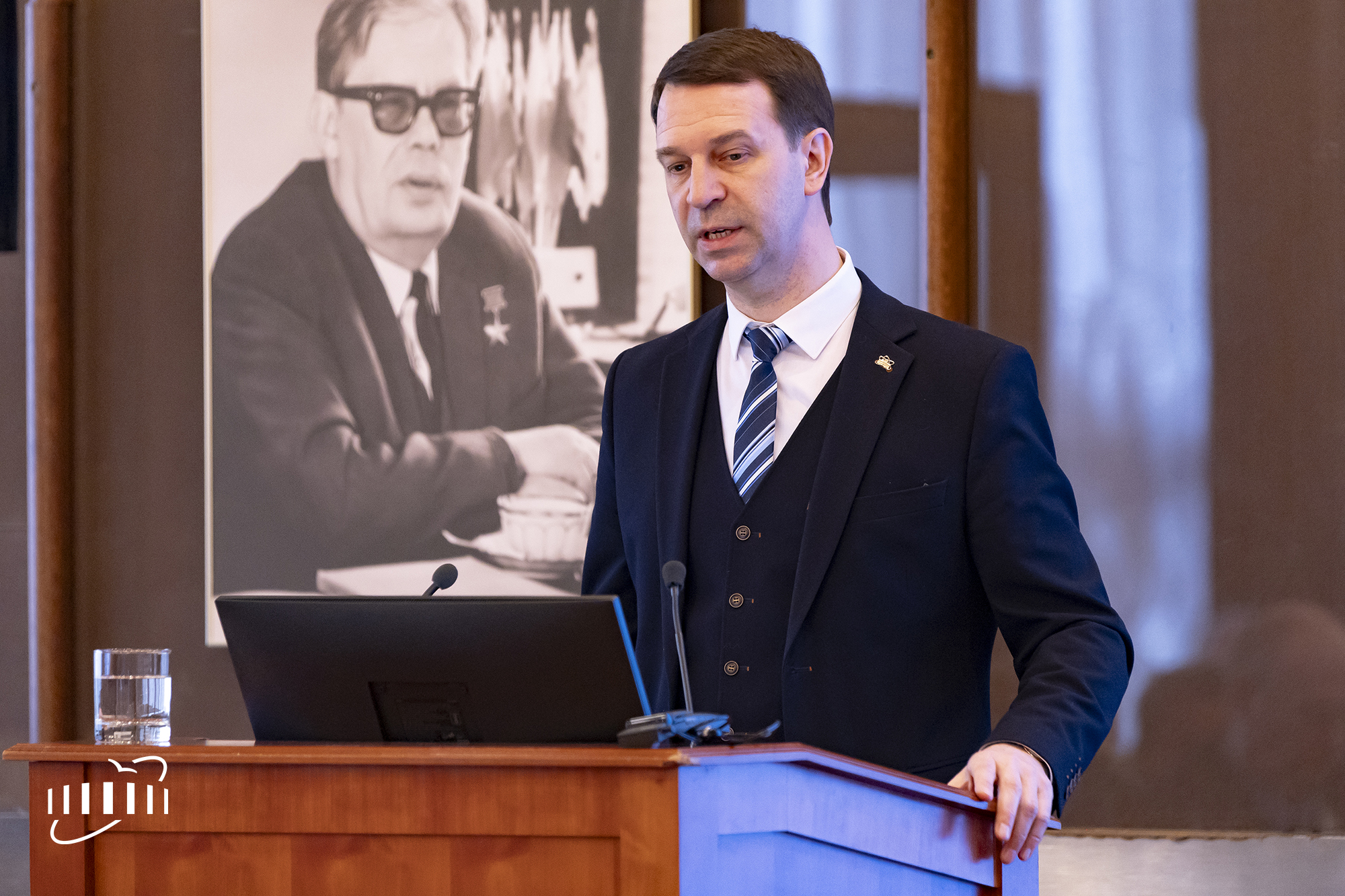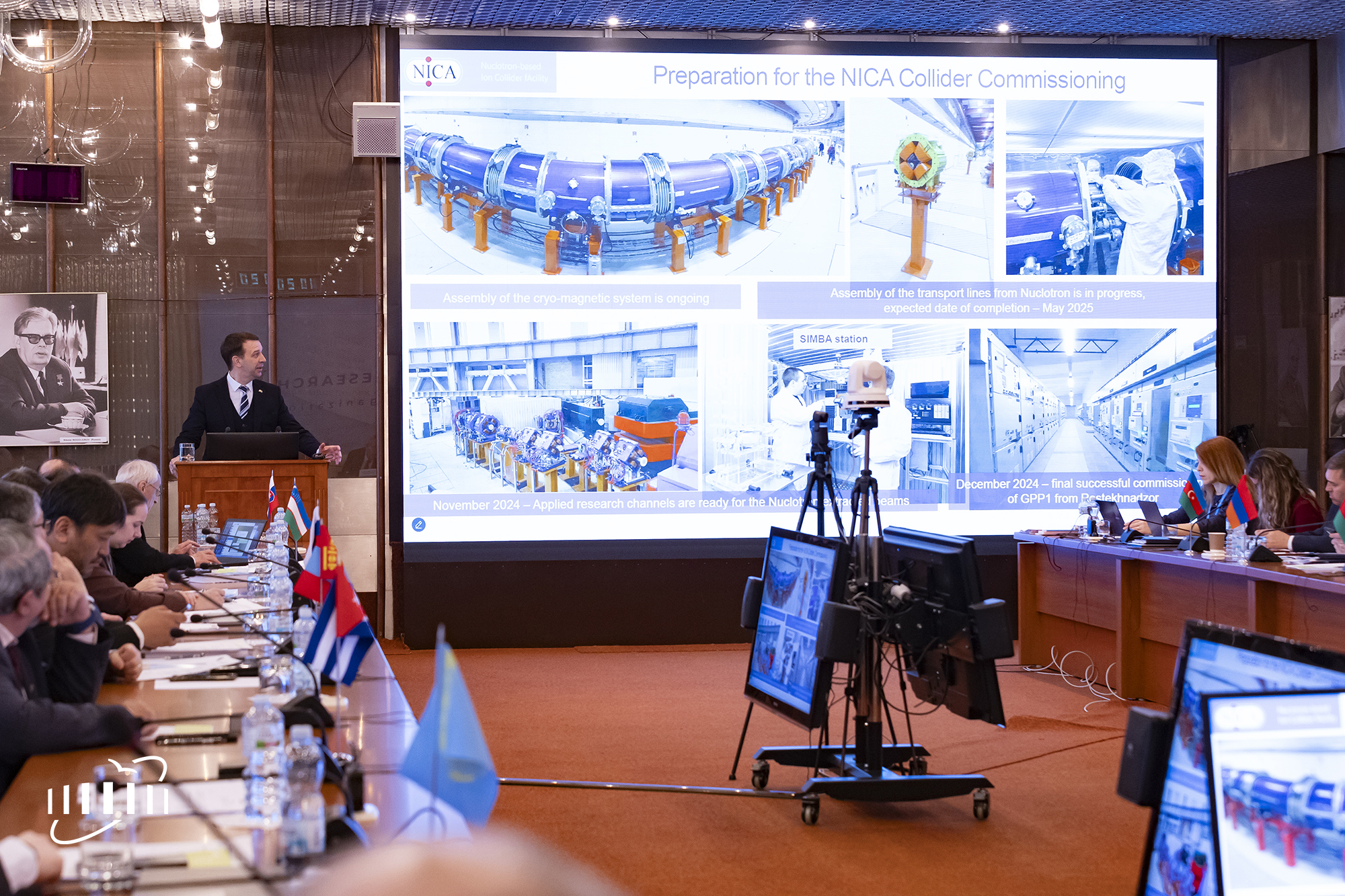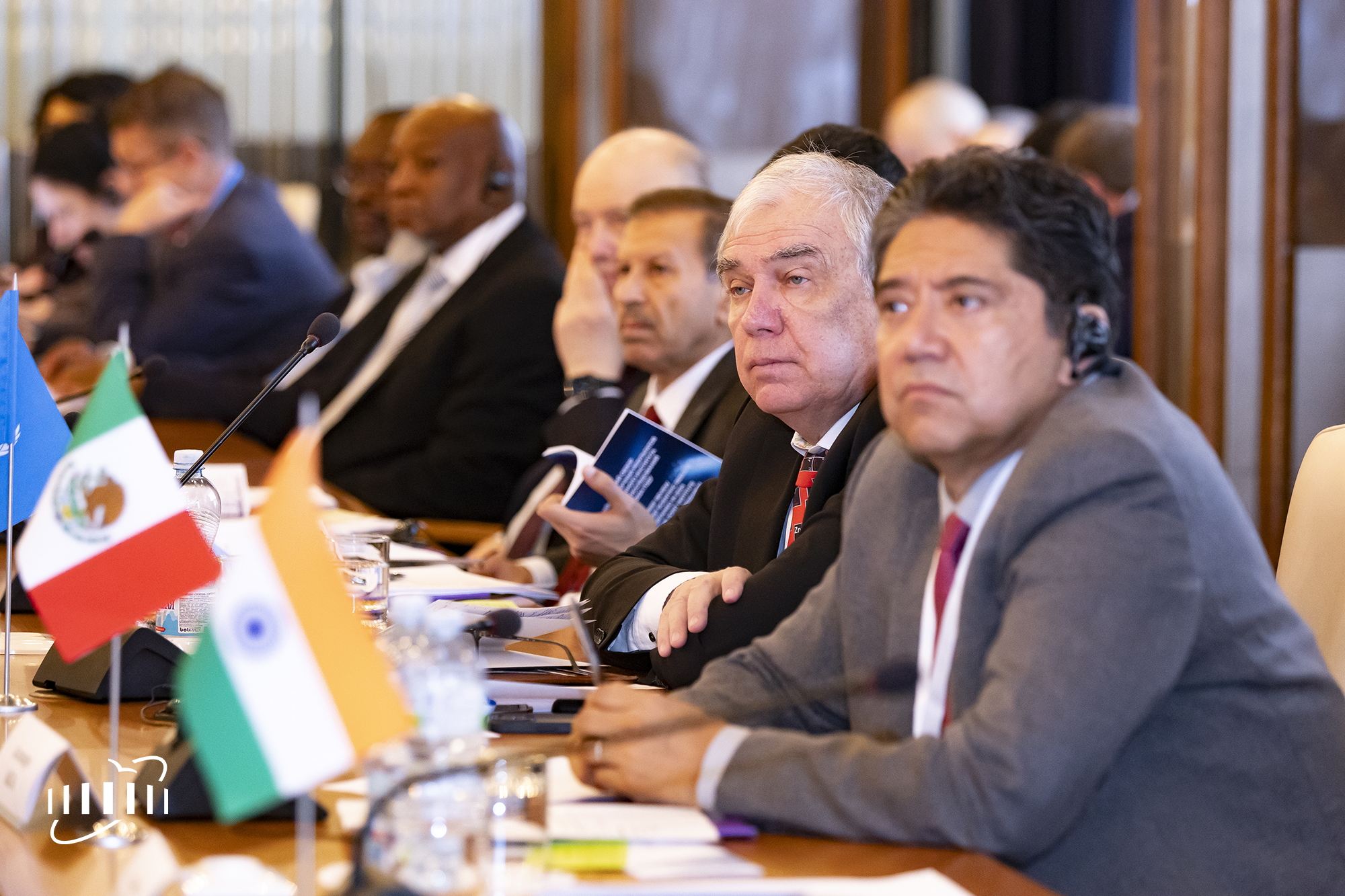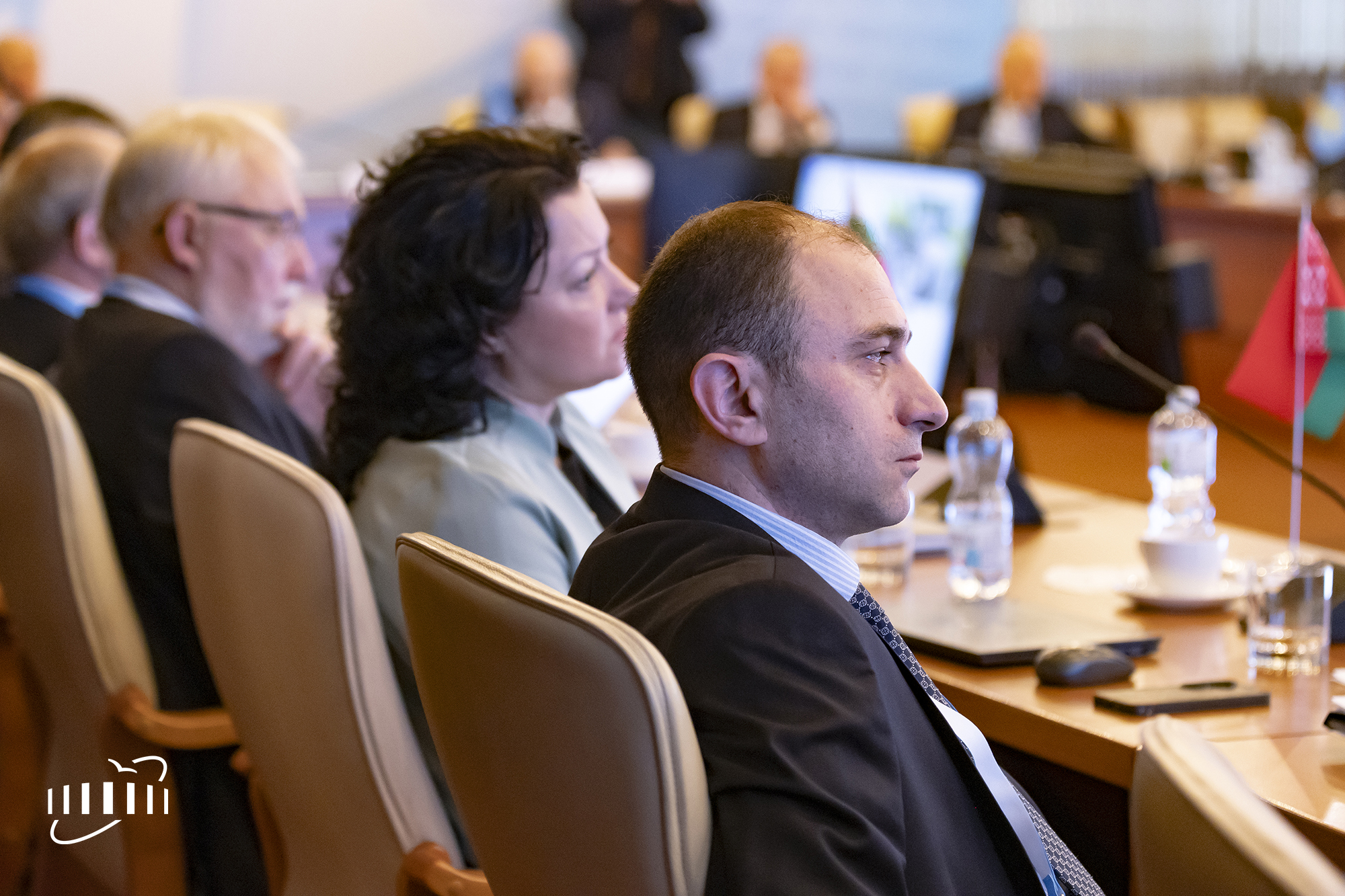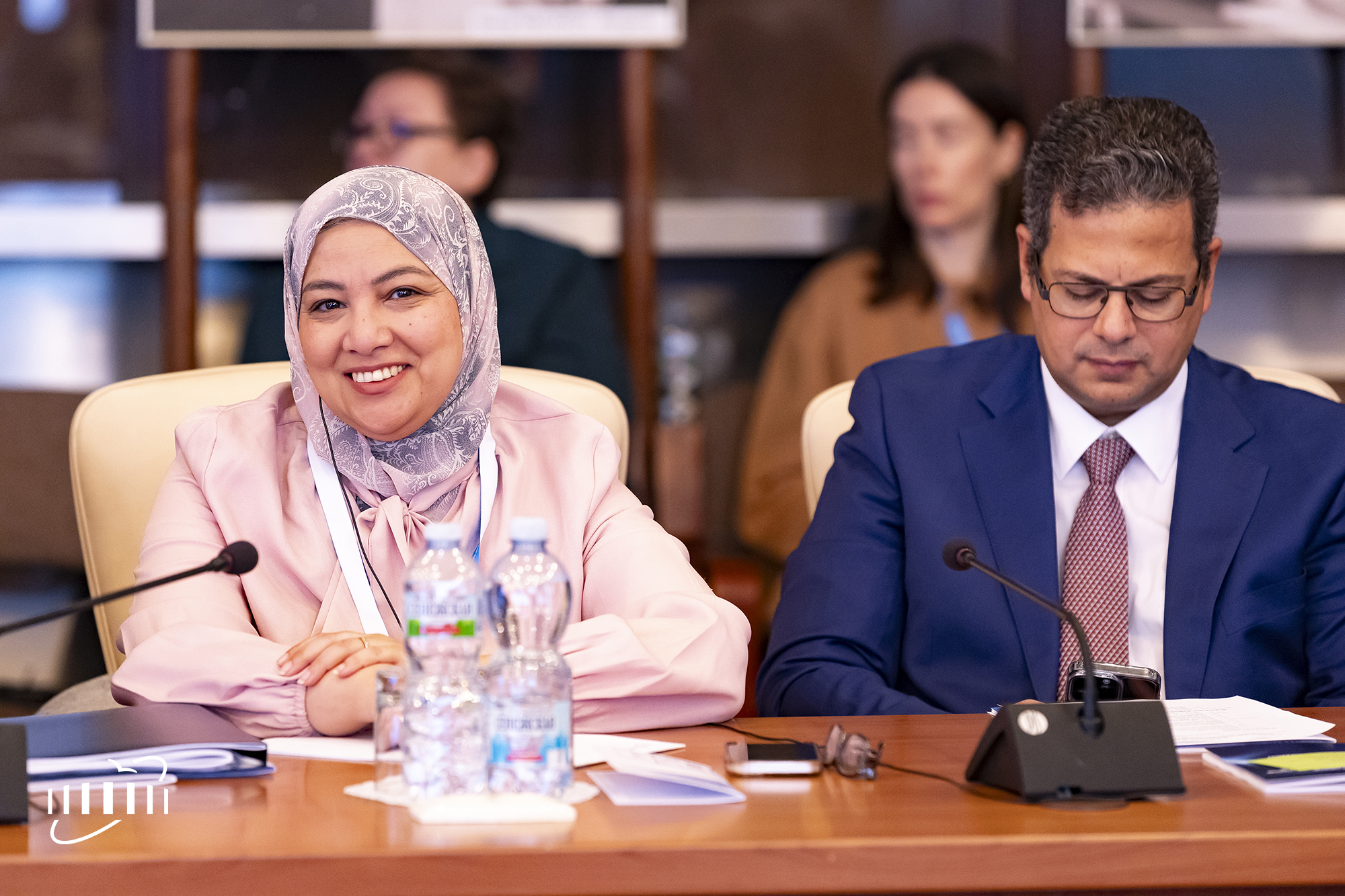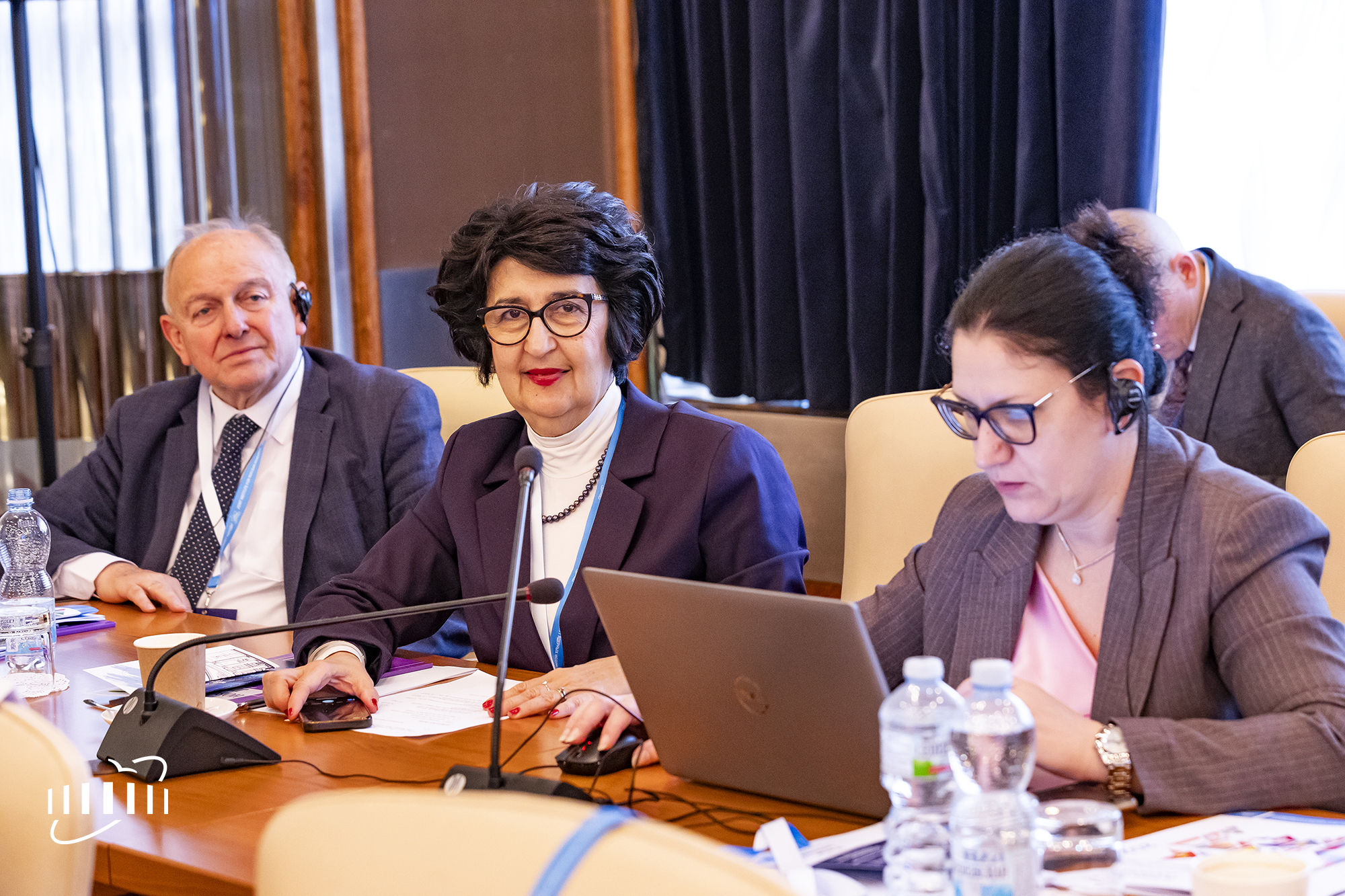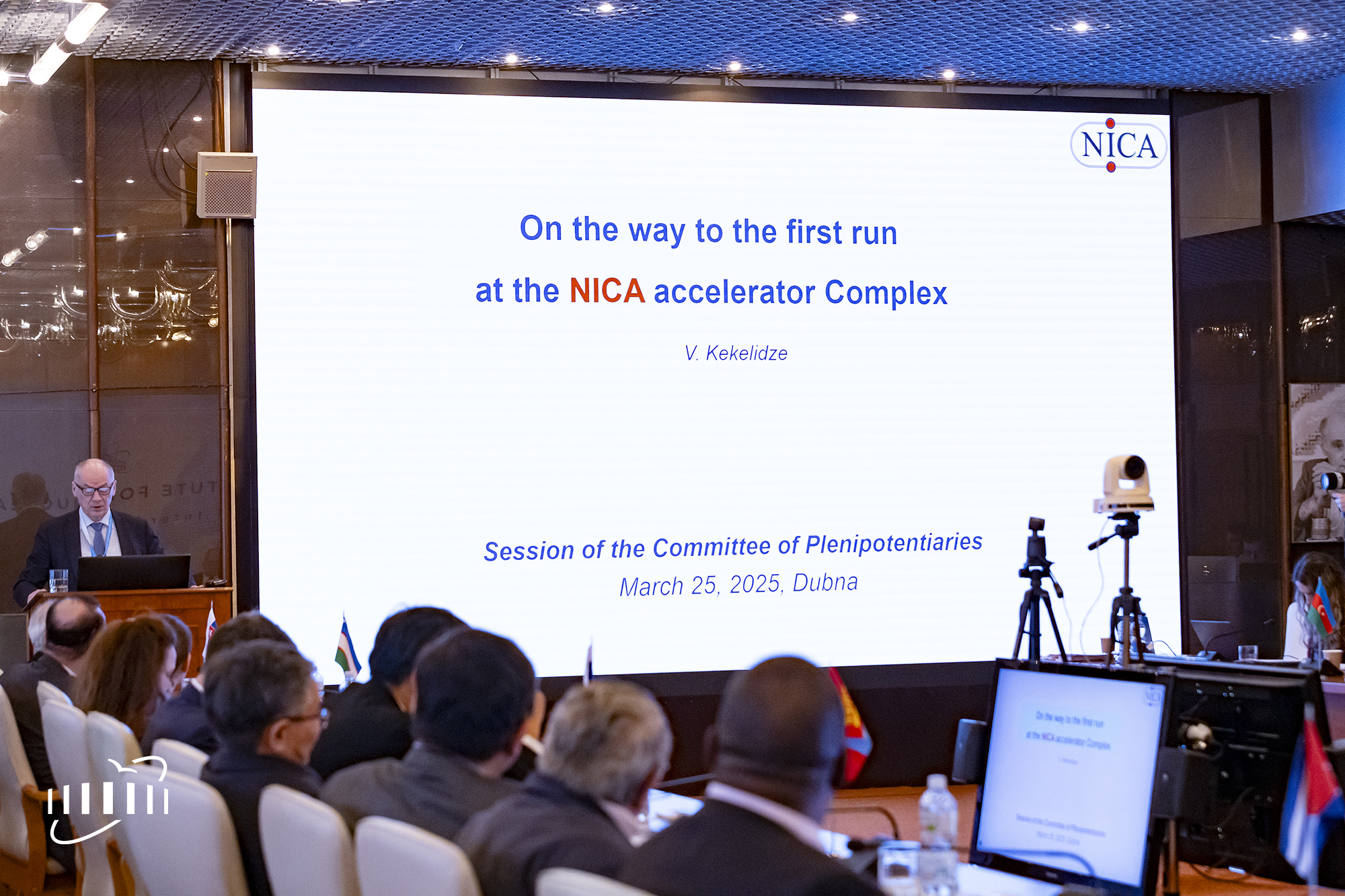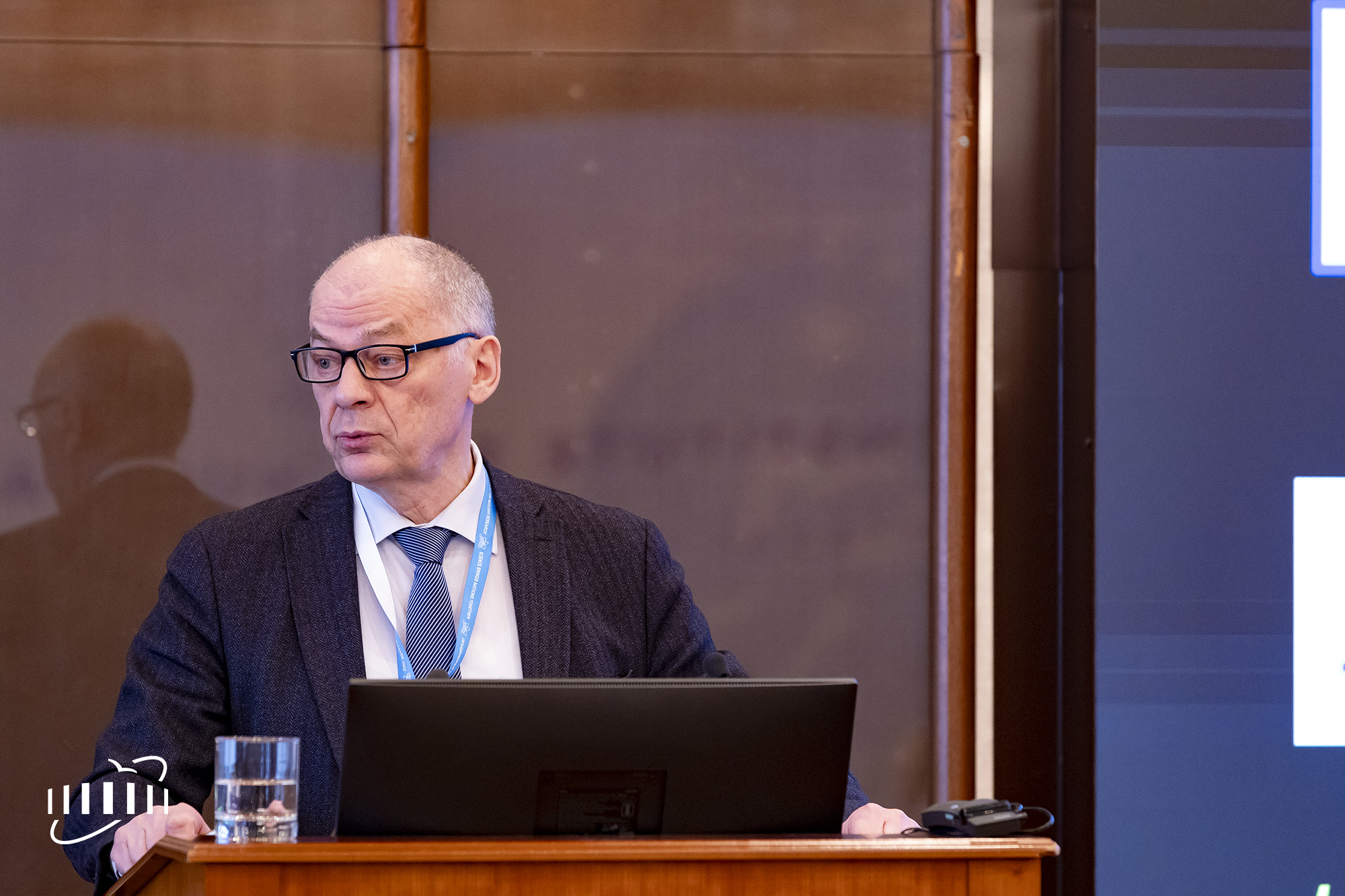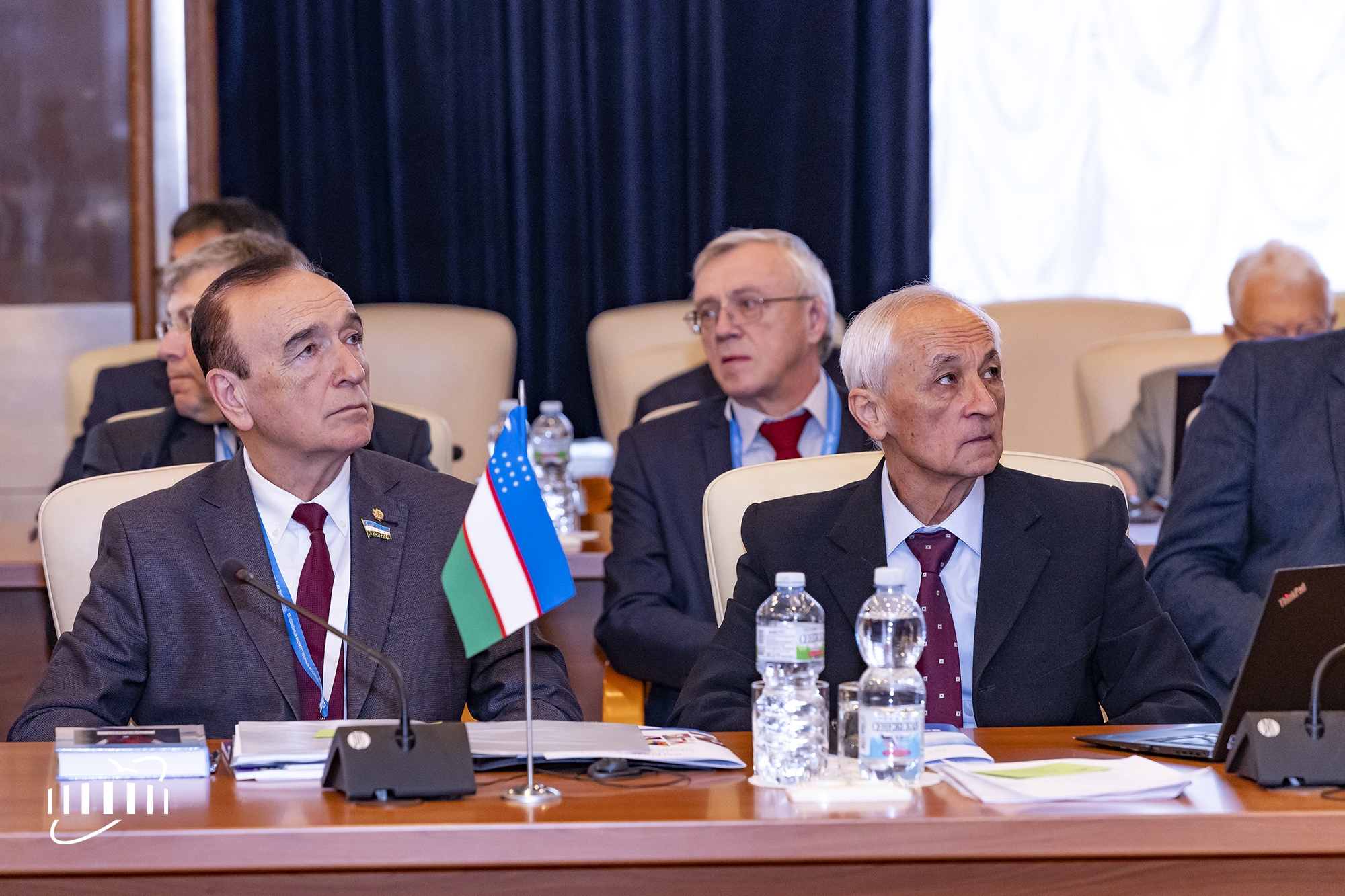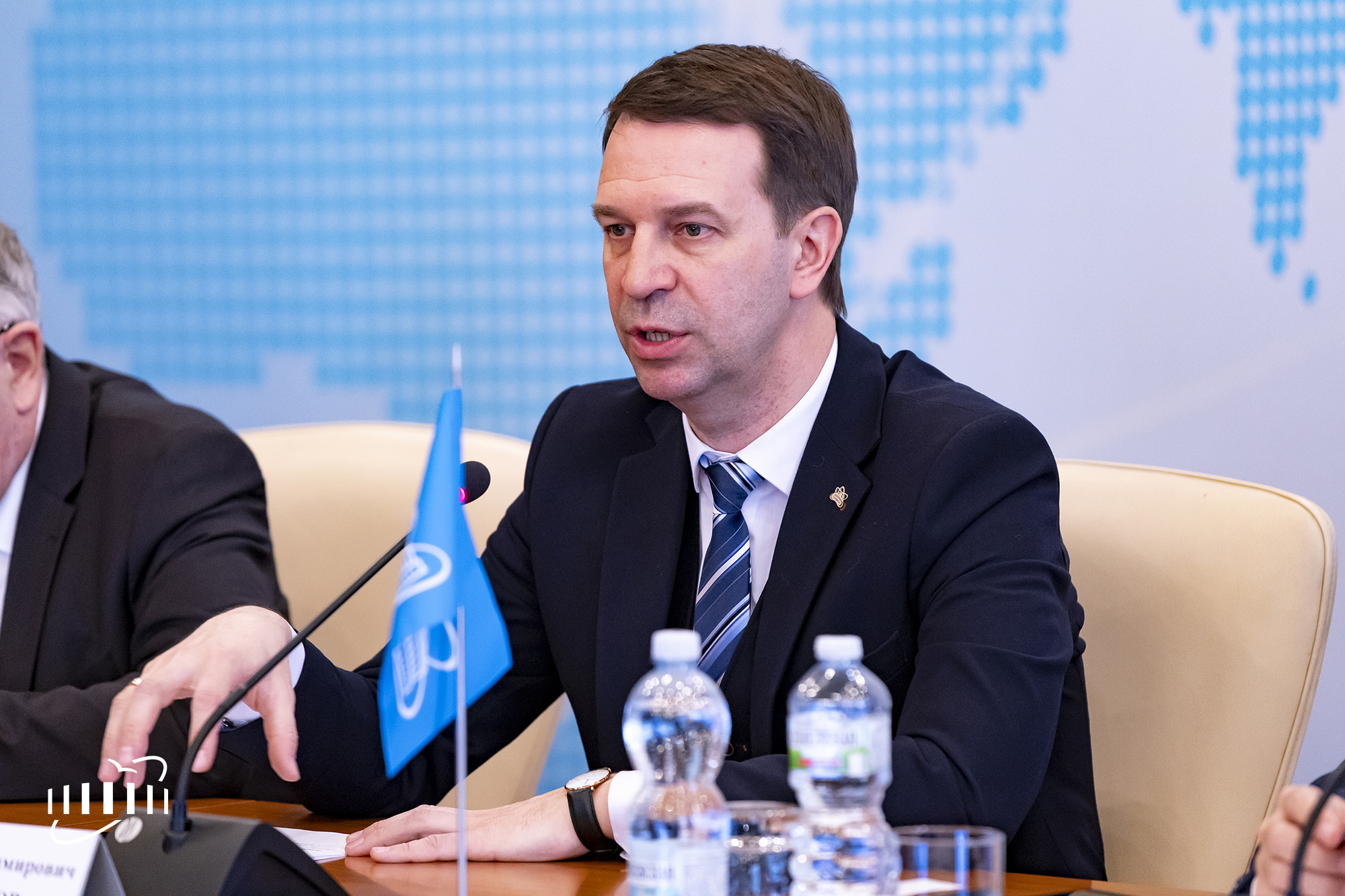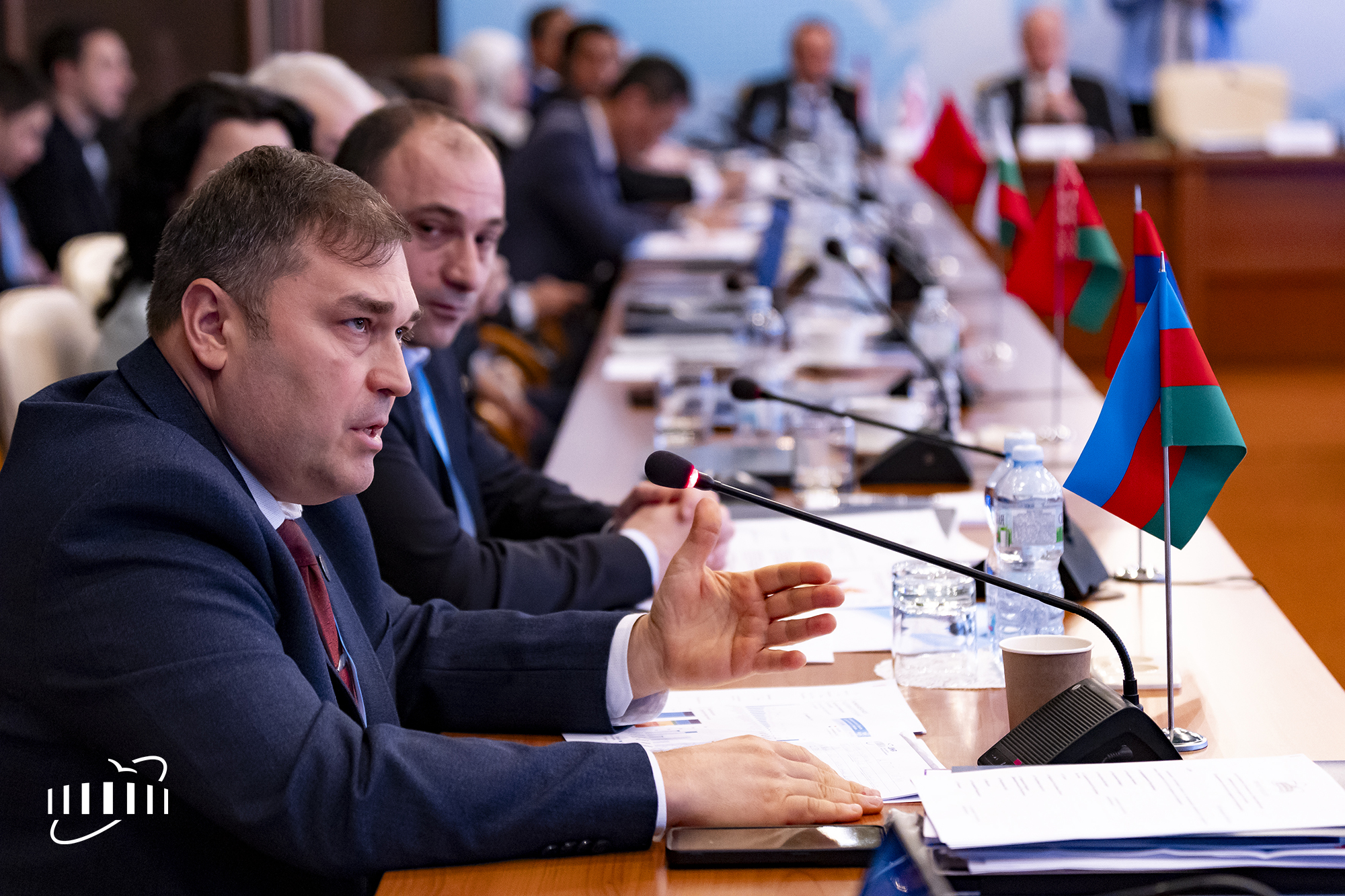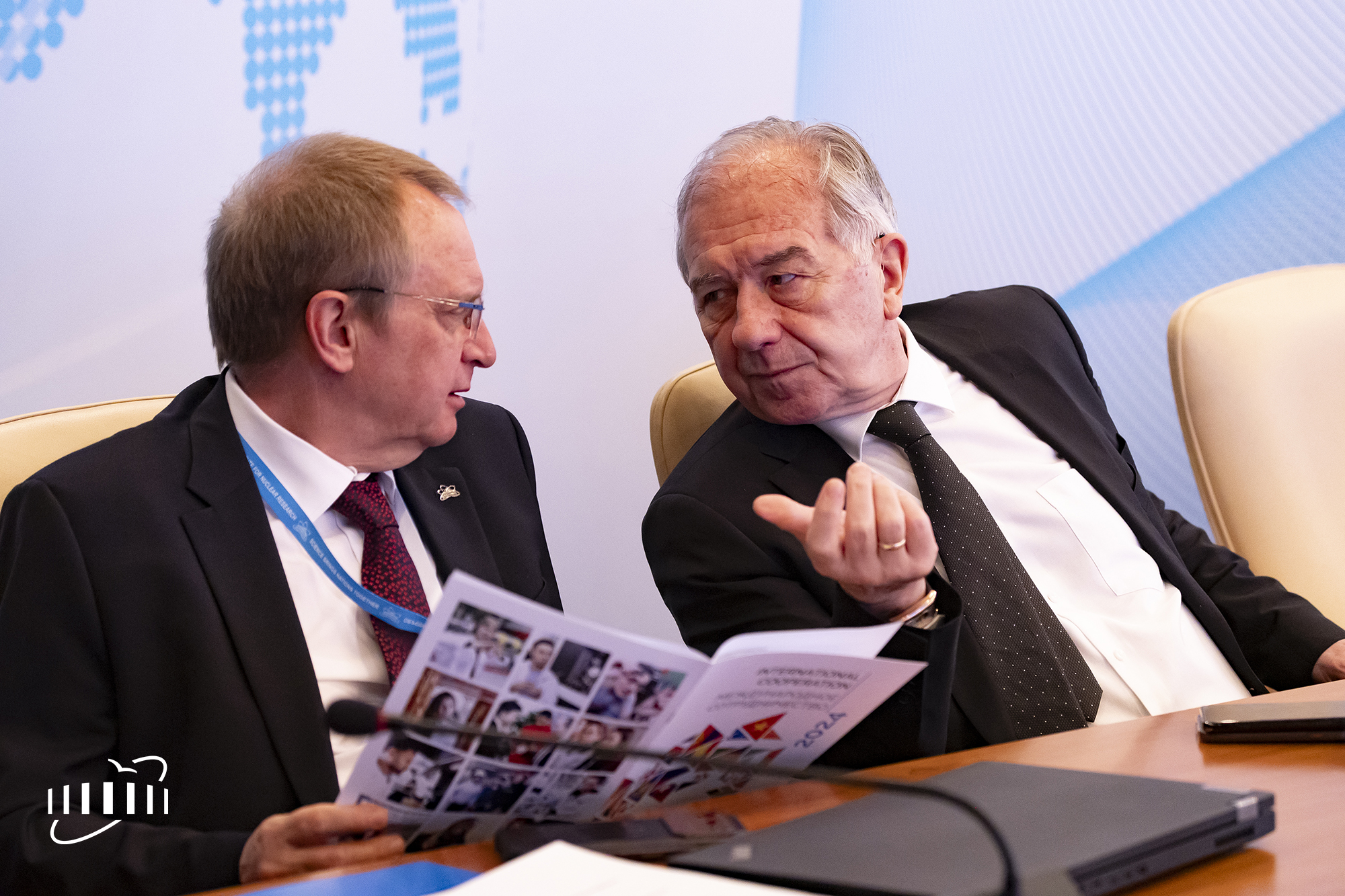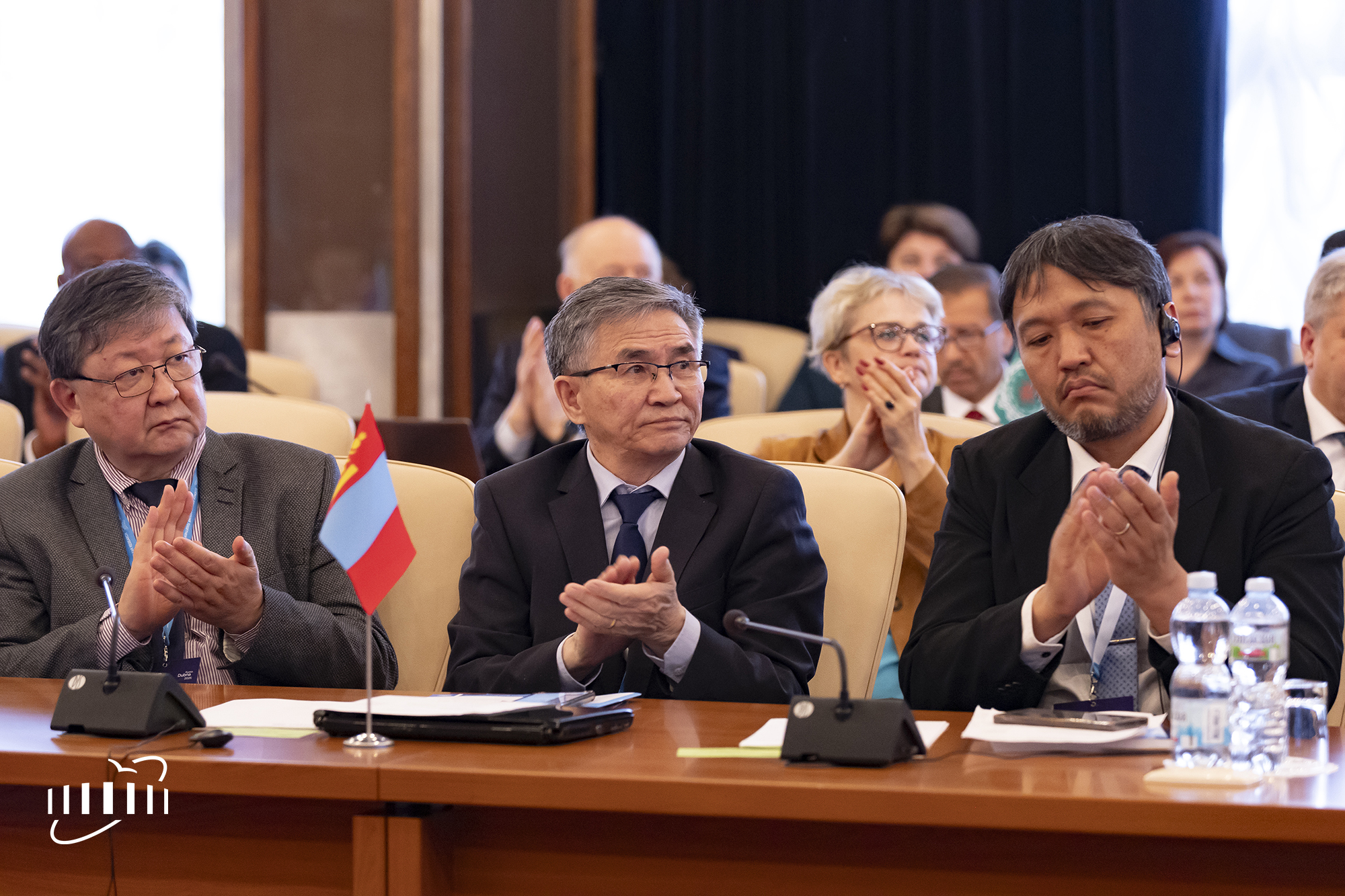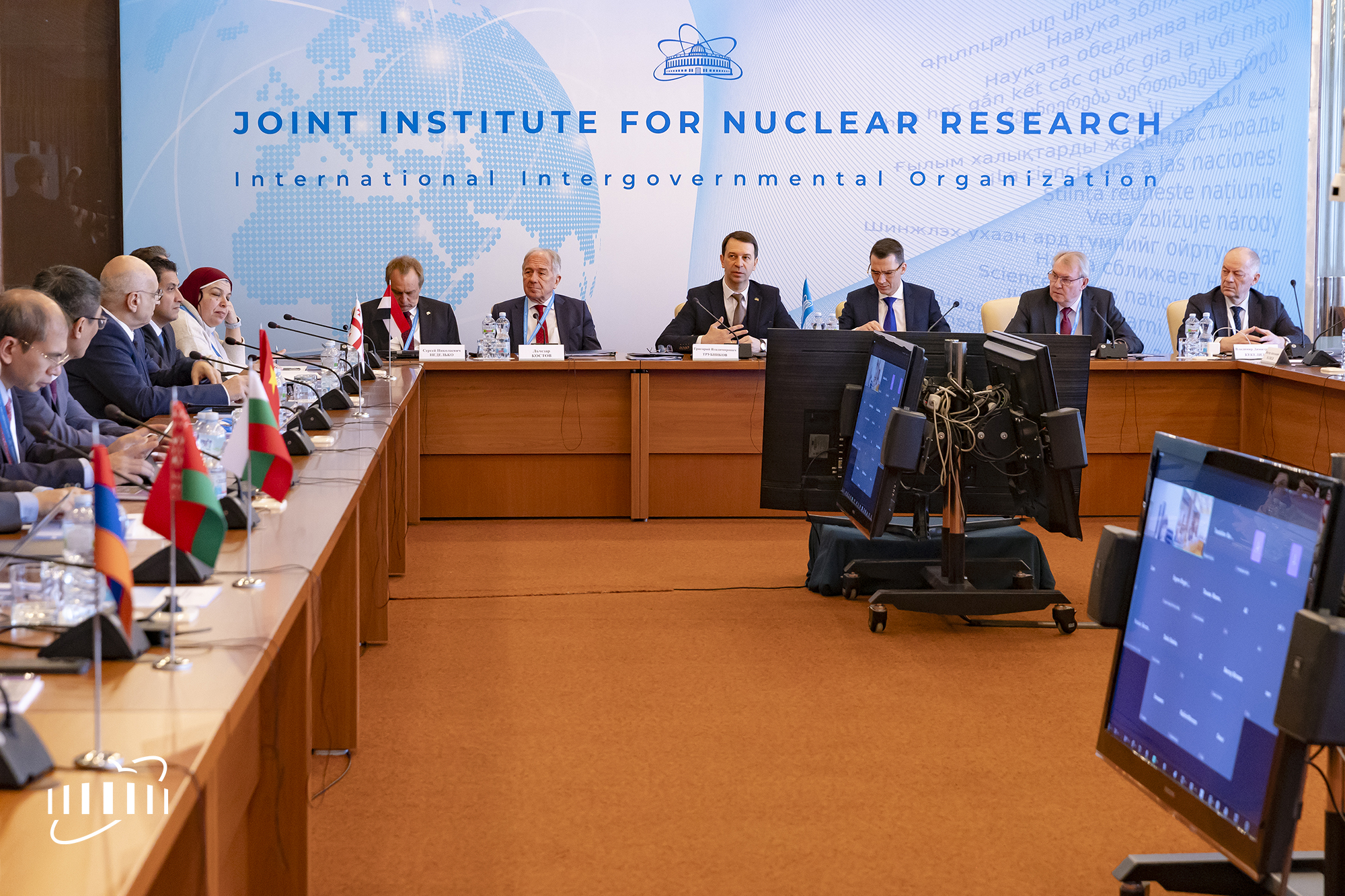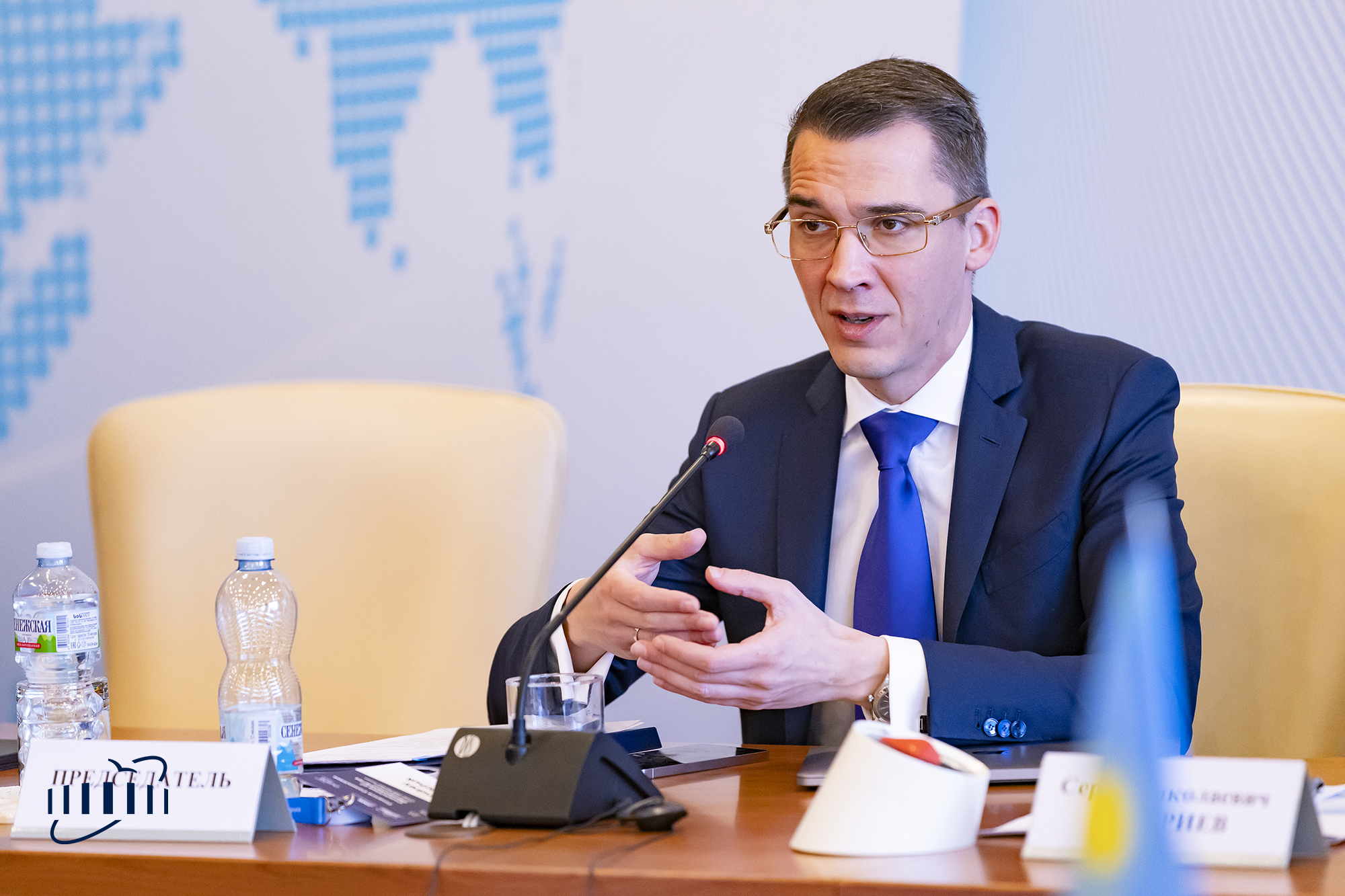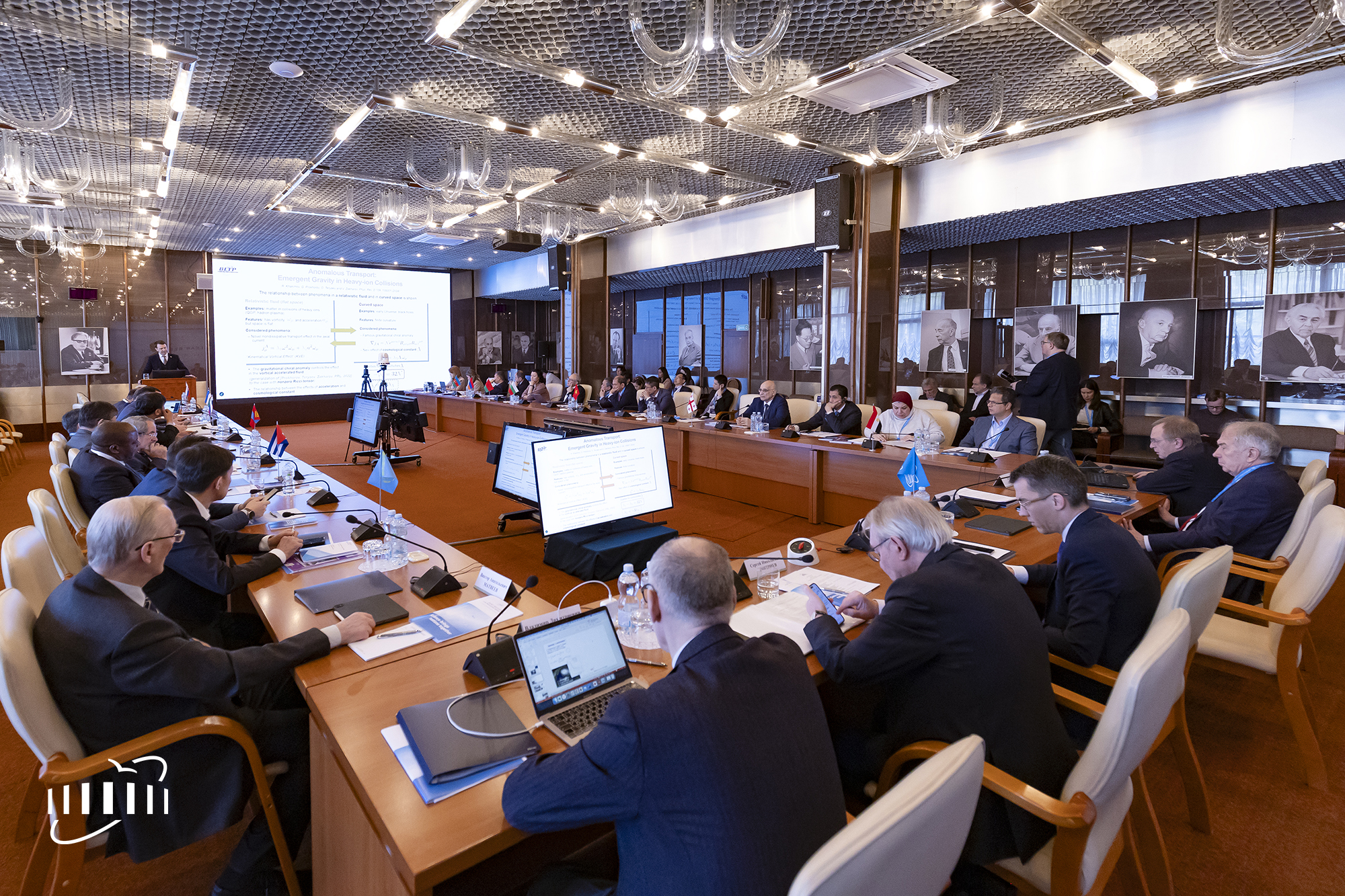CP JINR session: director election and first NICA run
News, 26 March 2025
From 24 to 25 March 2025, a meeting of the JINR Finance Committee (FC) and a session of the main governing body of the Joint Institute for Nuclear Research, the Committee of Plenipotentiaries (CP) of the Governments of the JINR Member States, took place at the JINR International Conference Centre (ICC). The committees’ members summarised the results of the previous financial year and considered the budget for the current year. On the day of the CP session on 25 March, the first run at the NICA Accelerator Complex was initiated. JINR Director, Academician of the Russian Academy of Sciences (RAS) Grigory Trubnikov was re-elected for a second term starting from 1 January 2026.
Finance Committee
Deputy Minister of Science and Higher Education of the Russian Federation Andrey Omelchuk chaired the JINR Finance Committee meeting on 24 March. JINR Director, RAS Academician Grigory Trubnikov gave a talk about the scientific achievements of the Institute, its key projects and activities. Head of the Budget and Economic Policy Department Nikolay Kalinin made a presentation on the execution of the 2024 JINR budget and introduced the FC members to the draft of the revised 2025 JINR budget. JINR Vice-Director Latchesar Kostov announced that the Korsakov and Partners LLC will audit JINR’s financial activities in 2024.
Procurement digitalisation
The presentation by Mikhail Vasiliev, Head of the Department of Digital Services Development at JINR (DDSD), focused on the switching of the Institute’s procurement processes from the Dubna Electronic Document Management System to a new one. The DDSD Head noted that the transition to a modern electronic document management system is inevitable in today’s environment, where more and more of the Institute’s counterparties are abandoning paper document management. Unlike the existing one, the new system should be integrated with other JINR information systems in real time, including external data providers. As Mikhail Vasiliev explained, many of JINR’s procurement processes are similar to those of large corporations, so the choice for a new system for automating the Institute’s procurement activities was made in favour of a service developed by VESNA (Digital Development Laboratory JSC), a subsidiary of Gazprombank’s Electronic Trading Platform. In early 2025, the Institute signed an agreement with this company to conduct a survey of JINR’s existing procurement processes and information systems used to automate them. Based on the results of the work under the contract, a detailed project plan for switching to a new procurement system should be prepared. According to the plan, the development of a project to create the new system will begin in the second quarter of this year, meaning that the system will be ready for testing and the gradual switching will be completed by mid-2026. As a result, all procurement processes should be managed entirely in the new system by the end of 2026.
The Finance Committee members listened to a talk by a VBLHEP JINR leading researcher Arkady Taranenko entitled “Cosmic matter in a laboratory: the BM@N Experiment (NICA)”.
CP JINR session
The session of the Committee of Plenipotentiaries of the Joint Institute for Nuclear Research chaired by Plenipotentiary Representative of the Republic of Georgia at JINR Arsen Khvedelidze took place on 25 March. Representatives of the JINR Member States and delegations from Serbia, South Africa, and the Arab Atomic Energy Agency (AAEA) joined the meeting. In addition, the session was attended by JINR Scientific Council Co-Chair, Academician of the National Academy of Sciences of Belarus Sergey Kilin, IAEA Deputy Director General Mikhail Chudakov, Counsellor of the Science and Technology Wing of the Embassy of India in Russia Anand Kamavisdar, Counsellor of the Embassy of China in Russia Miao Fei, a member of the JINR–Mexico Joint Coordination Committee Alejandro Ayala, and COMET Project Head Satoshi Mihara.
The Director of the Joint Institute, RAS Academician Grigory Trubnikov, opened the spring CP session. In his overview presentation, he spoke about the scientific achievements and the most important events of the Institute over the past year and presented the results of the JINR Directorate’s work from 2021 to 2025.
The key events of the 137th session of the Scientific Council of the Joint Institute for Nuclear Research held in February were the test launch of the IBR-2 Research Reactor after a long shutdown and the commissioning of a new main facility, the LINAC-200 Linear Electron Accelerator. During the meeting, the election of the FLNR Director was held; Sergey Sidorchuk was re-elected for a five-year term, and Alla Boreyko and Ivan Padron Diaz were appointed LRB Deputy Directors. Following the session, the First Plenipotentiary Representative of the Arab Republic of Egypt at JINR Mahmoud Sakr was awarded the title of JINR Honorary Doctor for his great personal contribution to enhancing the role of the Arab Republic of Egypt in the research activities of the Joint Institute and strengthening scientific cooperation.
One of the significant achievements of the Institute was the publication of the new JINR peer-reviewed journal, Natural Science Review, in December 2024. According to Grigory Trubnikov, the second issue of the journal is ready and is scheduled for publication in the near future.
Departments
The Veksler and Baldin Laboratory of High Energy Physics is preparing for the start of the experimental programme of the NICA Accelerator Complex. At the moment, the collider’s cryomagnetic system is assembled, and cryogenic tests and preparation of magnets for operation with design currents will begin in the coming months. According to Grigory Trubnikov, all necessary equipment will be installed at NICA by the middle of this year.
“Currently, the installation of the parts of detector systems on the operating positions of the Multi-Purpose Detector (MPD), the heart of the NICA Complex, continues,” the JINR Director said. During the first two quarters of 2025, specialists plan to conduct magnetic measurements of the three-dimensional field map of the superconducting solenoid, which was cooled down to operating temperatures for the first time in December 2024. In the autumn, the detector will be installed in the normal position, and by the end of the year, the first experiments with colliding heavy ion beams will begin.
In addition, the innovative applied research programme at NICA is actively developing. Today, the ARIADNA Collaboration brings together scientists and specialists from more than 30 organizations from around the world. In 2024, the researchers published over 30 scientific papers based on the results of experiments in peer-reviewed journals and obtained two patents.
Experiments on livermorium synthesis using 50Ti and 54Cr beams were conducted as part of the preparation for the synthesis of elements 119 and 120 at the Superheavy Element Factory at the Flerov Laboratory of Nuclear Reactions. Moreover, FLNR JINR scientists discovered three new isotopes: 288, 289Lv, and 280Cn. The total operating time of the accelerator complex in 2024 was 4050 hours. In addition, Grigory Trubnikov highlighted major international events held with the support of FLNR as some of the most outstanding and productive: the 50 Years of Cold Fusion conference in Armenia and the International African Symposium on Exotic Nuclei (IASEN-2024) in South Africa.
The Baikal neutrino telescope is the flagship project of the Dzhelepov Laboratory of Nuclear Problems. During the latest expedition, a team of scientists from the Baikal-GVD Collaboration managed to deploy a new, 14th cluster consisting of more than 400 optical modules in a short time, a month and a half. In addition, they successfully repaired several previously installed clusters that have been operating since 2018. A notable achievement was the deployment of a unique next-generation string consisting of 20 optical modules by a scientific group from the Chinese Institute of High Energy Physics (IHEP) in the final days of the expedition. Over the past 4 years, the Baikal Telescope registered about 50 ultrahigh energy neutrino events.
DLNP JINR employees are actively involved in advanced international neutrino experiments such as JUNO, T2K, and NOvA. In addition, they are upgrading the telescopes of the TAIGA Gamma-Ray Observatory at the Tunka Valley astrophysical site (Russia) together with Moscow State University and several RAS institutes.
In 2024, the Bogoliubov Laboratory of Theoretical Physics organized 11 major international events, including scientific schools, conferences, meetings, and seminars. Among important events for the Institute’s international scientific affairs was BLTP JINR signing two cooperation agreements with the Institute of Theoretical Physics of the Chinese Academy of Sciences (ITP CAS) and the Federal University of Juiz de Fora (UFJF) in Brazil. As Grigory Trubnikov noted, BLTP researchers continue to demonstrate outstanding scientific results published annually in the most prestigious international journals.
The Joint Institute for Nuclear Research continues to contribute to the development of the CERN collaborations at the Large Hadron Collider (LHC) for the second stage of modernisation of the CMS, ATLAS, and ALICE Detectors. JINR scientists are actively involved in the experimental programme at the Super Proton Synchrotron (SPS).
The Multifunctional Information and Computing Complex (MICC) at the Meshcheryakov Laboratory of Information Technologies annually performs a significant amount of data processing and physical process modelling for not only JINR’s megascience experiments, but also the Institute’s partners. In 2024, reliable and stable operation of the main MICC systems, including the Tier-1 and Tier-2 Data Centres, cloud infrastructure, and the Govorun Supercomputer, was ensured. A total of 635 000 user tasks were completed using data provided by the MPD, BM@N, and SPD Collaborations. The JINR Director emphasised that the Tier-1 Centre still holds the first place in the world for processing data from the CMS Experiment at CERN, and the Tier-2 Centre became the most productive in the Russian Data Intensive Grid (RDIG).
Specialists modernised the spectrometer complex and developed new experimental equipment at the Frank Laboratory of Neutron Physics before the start of the IBR-2, in parallel with the preparation of technological and engineering systems for the pulsed reactor. For example, new detectors were installed in the HRFD and DN-6 Diffractometers. A prototype of the BJN spectrometer, developed and created by FLNP scientists, is currently being prepared for testing. Grigory Trubnikov informed the Plenipotentiaries of the Governments of the JINR Member States about the start of registration for participation in experiments using neutron beams at the IBR-2 Reactor as part of the FLNP user programme. The experiments will be carried out from October to December 2025.
New research equipment, designed for accurate analysis of rare cell populations, experiments with laboratory animals, and further research into the effects of radiation on their brains was purchased and installed at the Laboratory of Radiation Biology.
In February 2025, the JINR University Centre held the first Teachers of the Future school and seminar in Dubna, gathering 23 students of Russian universities. Its main goal is to supplement the curricula of educational programmes of natural science faculties with relevant knowledge in modern physics and to provide future teachers with basic information about the research and engineering activities that implement advanced methodologies.
The result of ten years of work of specialists from UC and other JINR laboratories was the publication of textbooks approved by Russia’s Ministry of Education, “Physics 7-9. Engineers of the future” for students in grades 7-9. Work is underway to create an English edition and new advanced physics textbooks for grades 10 and 11.
Cooperation
Since the previous CP session, which was held in Minsk, a significant number of meetings and events devoted to discussing international cooperation development took place with the participation of representatives of Member States and partners of the Joint Institute for Nuclear Research. Over the past five months, JINR delegations paid working visits to several CIS countries, such as Belarus, Azerbaijan, and Uzbekistan.
In February 2025, the Joint Institute hosted a meeting with representatives of the Vietnam Atomic Energy Institute (VINATOM). At FLNP, the parties agreed to intensify the development of research facilities for the reactor being designed in Vietnam and to involve Vietnamese scientists, students, and postgraduates in the work carried out at the IBR-2 Reactor in order for them to gain experience in creating spectrometer elements and operating extracted beam facilities.
Cooperation with scientific organizations of the Russian Federation is advancing as well. On 22 November 2024, JINR hosted a RAS delegation headed by its President, Gennady Krasnikov. During the working meeting, the parties discussed not only cooperation between RAS institutes and JINR, but also topics related to developing scientific infrastructure and training qualified personnel in Russia.
In February 2025, the second International School on Nuclear Methods and Applied Research in Environmental, Material and Life Sciences, NUMAR-2025, took place in Havana with the support of the Plenipotentiary Representative of the Republic of Cuba at JINR Gonzalo Walwyn Salas. Leading researchers from the Joint Institute and scientific organizations of Cuba, Mexico, Brazil, Argentina, and South Africa read lectures for students and young professionals from Latin American countries. In addition, during the visit to Cuba, the cooperation agreement between JINR and the University of Havana was renewed.
Collaboration with European countries continues to advance. In November 2024, during the JINR delegation’s visit to Hungary, a trilateral agreement was signed with the University of Debrecen and the Institute for Nuclear Research (ATOMKI) to strengthen cooperation in personnel training, academic mobility programmes, research, and organization of joint events, including schools and conferences. During the 137th Scientific Council session, the Joint Institute hosted representatives of the Vinča Institute (Serbia).
Partnerships with China and India are reaching a new level. On 21 February 2025, a workshop on superconducting cavities took place at VBLHEP as part of cooperation between the Joint Institute for Nuclear Research and the Institute of Modern Physics of the Chinese Academy of Sciences (IMP CAS). At the event, the parties discussed key projects and prospects of collaboration in developing accelerator complexes. In January, Ambassador Extraordinary and Plenipotentiary of the Republic of India to the Russian Federation Vinay Kumar paid an official visit to JINR. The key topic of discussion at the meeting with the Institute’s Directorate was JINR–India cooperation development.
In the final part of the talk, Grigory Trubnikov summarised the results of the JINR Directorate’s work from 2021 to 2025. Over the past four years, the Joint Institute continued to steadily grow. In parallel with developing advanced scientific infrastructure, JINR expanded cooperation with scientific and educational organizations from Member and Associate Member States, as well as partners. The number of international experts representing JINR’s Governing and Advisory Bodies increased. During this period, more than 600 new employees joined the Institute’s laboratories.
The Director of the Joint Institute highlighted the support programme of the Ministry of Science and Higher Education of Russia aimed at attracting specialists from Russian scientific and educational centres to work on the JINR megascience projects. Since the establishment of the programme, 325 new participants from 14 Russian organizations got involved in research at the NICA Accelerator Complex, and 110 participants from seven organizations joined the Baikal-GVD Project. “We hope that other Member States will consider introducing similar initiatives aimed at supporting national research teams as well,” Grigory Trubnikov concluded.
At the beginning of 2025, JINR launched its first startup competition aimed at supporting innovative projects by young JINR specialists. This initiative is designed to promote R&D activities that correspond to the priorities of the JINR Member States’ scientific and technological advancement, along with developing the Institute’s human resources. The results of the competition will be announced in summer 2025.
“Today, the Joint Institute for Nuclear Research has a unique opportunity to actively support the JINR Member States in creating modern scientific infrastructure on their territories,” Grigory Trubnikov stressed. “This should certainly contribute to the development of not only national, but also global science”.
About first run at NICA Accelerator Complex
JINR Vice-Director, RAS Corresponding Member Vladimir Kekelidze spoke not only about the plan for the phased launch of the complex’s accelerators, but also about the history of the megascience project, its progress, the work of four collaborations within the project, the first scientific results of the latest commissioning run, and the fundamental science problems that the NICA Complex is aimed to resolve.
“We are entering a new era of the project, when we move from construction to the obtaining of new scientific data. International collaborations are working successfully and are getting results of international importance. NICA has huge research potential, and it is very important to attract a multitude of new participants to our project: students, postgraduates, and researchers from all over the world,” Vladimir Kekelidze noted. The JINR Vice-Director expressed gratitude to the Ministry of Science and Higher Education for providing support through grants, which allowed involving more scientists in work at NICA.
In the first half of the day, CP session participants visited the NICA Accelerator Complex, where the ceremony of initiating NICA’s run 1 took place. The linear accelerator, Booster, and Nuclotron will circulate xenon beams. In August, the collider will be operated with heavy ion beams. About 700 employees are involved in the run. “This is a celebratory and symbolic moment for the Joint Institute for Nuclear Research. Representatives of almost 20 Member and Partner States of the Institute are present today. This moment marks the culmination of the ten-year journey that started with the laying of the complex’s foundation stone in 2016,” Grigory Trubnikov said.
Scientific and social expenses
In the second part of the session, Nikolai Kalinin gave a talk on the execution of JINR’s 2024 budget and the draft of the revised JINR budget for this year. In particular, the Head of the Budget and Economic Policy Department spoke about the funds aimed at developing JINR’s large scientific infrastructure, material cost execution in research, social infrastructure repairs, salary indexation, etc.
CP approved the consolidated adjustment of the 2024 JINR budget’s expenses and the revised 2025 JINR budget.
Results of Finance Committee meeting
Andrey Omelchuk discussed the results of the JINR Finance Committee meeting on 24 March. “The Joint Institute for Nuclear Research is a unique international scientific centre with impressive projects, including, for example, the creation of megascience facilities. Special attention is paid to financing promising research projects to develop science and support the research potential of young people. In addition, the Institute continues its digital transformation, which will increase its competitiveness as well,” Russia’s Deputy Minister of Science and Higher Education Andrey Omelchuk said.
Institute’s Director election
One of the key items on the session’s agenda was to call the election of the Institute’s Director, whose term ends on 31 December 2025. CP Chair Arsen Khvedelidze announced the rules for calling election and nominating candidates. CP members made a proposal to hold election at the current meeting.
The Committee of Plenipotentiaries unanimously decided to schedule the election of the JINR Director for the current CP session and to approve Academician Grigory V. Trubnikov as a candidate for JINR Director’s election. According to the voting results, in accordance with the JINR Charter and the JINR Regulation for the Election of Directors, Grigory Trubnikov was unanimously elected as the JINR Director for a five-year term starting with 1 January 2026. He expressed gratitude to the JINR Member States’ plenipotentiaries for their trust and appreciation of the work of both the Directorate and all employees of the Institute.
NICA to continue research started by Institute’s founding fathers
JINR Scientific Leader, RAS Academician Victor Matveev made a scientific talk entitled “To the 60th anniversary of the hypothesis of colored quarks and the Dubna model of hadrons”. The speaker noted that the introduction of a new quantum number of quarks into particle physics and the concept of colour charge underlie the modern theory of strong interactions of quantum chromodynamics. Today, scientists are facing the task of studying the fundamental properties of dense and hot hadron matter, taking into account the physics of small and large distances and the role of quark and gluon degrees of freedom. It is necessary to achieve an understanding of the nature of the phenomena of quark confinement and deconfinement in phase transitions in superdense hot nuclear matter. Victor Matveev emphasised that solving this fundamental problem is the aim of JINR’s programme to create the NICA Heavy Ion Collider and the Superheavy Element Factory’s cyclotron complex.
2026, JINR’s anniversary year
Institute’s Chief Scientific Secretary Sergey Nedelko discussed plans of the organizing committee for the preparation of the 70th JINR anniversary celebration. Systematic work is underway to set up a full-fledged archive of the Institute. In recognition of the anniversary, a collection of essays on the JINR history will be published. The Institute’s website is planned to be updated next year. An exhibition space will be created at the ICC. The reconstruction of a two-storey building on the Mir Square, where the JINR Culture and History Centre will be located, is underway.
In 2025, leading up to the anniversary, JINR Days will be held in Uzbekistan, Azerbaijan, and Cuba, along with South Africa Days at JINR. A special issue of the JINR journal, Natural Science Review, will be published. In 2026, open days at JINR for employees’ family members will take place. Other scientific, sports, and cultural events are planned as well.
The session finished with a general discussion, the adoption of the CP decisions, and the signing of the protocol.
Alongside the CP session, the Directorate of the Joint Institute for Nuclear Research met with the Plenipotentiary Representative of Uzbekistan, President of the Academy of Sciences of the Republic of Uzbekistan Shavkat Ayupov and a delegation of South Africa. On 27 March, meetings with representatives of Mongolia and Serbia will take place.
The next JINR Finance Committee meeting and session of the Committee of Plenipotentiaries of the Governments of the JINR Member States will be held on 1–3 December 2025 in the Republic of Cuba.
